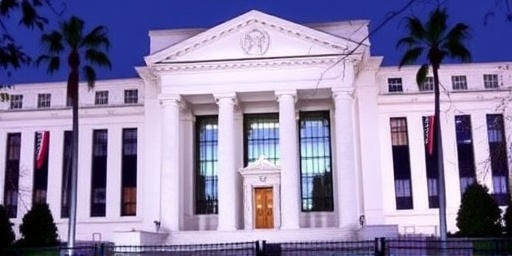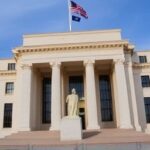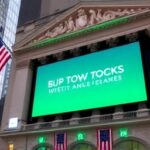In a move that sent ripples through financial markets, the US Federal Reserve has signaled it will likely hold off on an anticipated interest rate cut at its December meeting, driven by hotter-than-expected inflation data released today. The Consumer Price Index (CPI) rose 3.2% year-over-year in November, exceeding economists’ forecasts of 3.1%, reigniting fears that persistent inflation could derail the central bank’s easing efforts.
This development comes just weeks before the holiday shopping season peaks, with economists warning that sustained higher interest rates could dampen consumer spending and slow economic momentum. The Federal Reserve‘s cautious stance underscores the delicate balance between taming inflation and supporting growth in an uncertain economic landscape.
November Inflation Surge Exceeds Forecasts, Pressuring Fed’s Timeline
The latest inflation report from the Bureau of Labor Statistics painted a picture of stubborn price pressures that refuse to cool as quickly as hoped. Core CPI, which excludes volatile food and energy prices, climbed 3.7% annually, the highest reading since early 2023. Key contributors included a 0.4% monthly increase in shelter costs and a 2.1% jump in used vehicle prices, highlighting ongoing supply chain disruptions and wage growth outpacing productivity in service sectors.
Economists had anticipated a modest deceleration following October’s 3.2% headline inflation figure, but the uptick suggests that recent supply-side improvements—such as easing energy prices—may be insufficient to offset demand-driven inflation. Gasoline prices, for instance, fell 1.2% month-over-month but remain 15% higher than pre-pandemic levels when adjusted for seasonal trends. This data arrives amid broader economic indicators showing robust job growth, with nonfarm payrolls adding 199,000 jobs in November, further fueling inflationary concerns by indicating a tight labor market.
Federal Reserve Chair Jerome Powell, speaking at a press conference shortly after the data release, emphasized the bank’s data-dependent approach. “Inflation remains above our 2% target, and while we’ve made progress, the path forward is not linear,” Powell stated. His comments align with the Fed’s September projections, which penciled in only two rate cuts for 2025, down from earlier expectations of three or more.
To contextualize, the Federal Reserve has already implemented three 50-basis-point rate cuts since September, bringing the federal funds rate to a range of 4.75%-5.00%. However, today’s inflation tick-up has prompted traders to slash the probability of a December rate cut from 75% to just 22%, according to CME FedWatch Tool data. This shift reflects growing market consensus that the central bank may extend its pause into early 2025 to assess the full impact of prior easing.
Fed Officials Voice Caution on Interest Rate Path Amid Persistent Pressures
Behind the scenes, Federal Reserve officials are grappling with mixed signals from the economy. While gross domestic product (GDP) growth held steady at 2.8% annualized in the third quarter, forward-looking indicators like the Institute for Supply Management’s manufacturing index dipped to 48.5 in November, signaling contraction. Yet, inflation’s resilience has taken center stage, prompting divergent views among policymakers.
Atlanta Fed President Raphael Bostic, a known inflation hawk, reiterated his stance in a recent interview, saying, “We can’t afford to declare victory on inflation prematurely; higher interest rates may be necessary to anchor expectations.” In contrast, more dovish voices like those from San Francisco Fed President Mary Daly suggest that if inflation moderates in upcoming reports, a rate cut could still materialize, though the window is narrowing.
The Federal Open Market Committee’s (FOMC) November minutes, released last week, revealed a split: seven officials favored a December pause, while five pushed for a 25-basis-point reduction. Today’s data likely tips the scales toward the former, as it underscores risks of overheating if monetary policy eases too soon. Interest rates, held at multi-decade highs since July 2023, have successfully curbed some inflationary impulses—such as a decline in goods inflation from 5.8% to 1.2% over the past year—but services inflation lingers at 4.5%, driven by healthcare and education costs.
Analysts point to external factors exacerbating the situation, including geopolitical tensions in the Middle East that have pushed oil prices to $75 per barrel, up 5% this month. Additionally, proposed tariffs on imports from China and Mexico, floated by incoming administration officials, could add 0.5-1% to inflation in 2025, according to Goldman Sachs estimates. These elements complicate the Federal Reserve’s dual mandate of price stability and maximum employment, forcing a reevaluation of the pace for any future rate cuts.
Holiday Shopping Season Faces Headwinds from Higher Borrowing Costs
As Black Friday and Cyber Monday sales kick off, the specter of no December rate cut looms large over consumer wallets. Higher interest rates mean elevated costs for mortgages, auto loans, and credit card debt, potentially curbing discretionary spending during the critical holiday period. The average 30-year fixed mortgage rate stands at 6.8%, down from 7.8% peaks but still burdensome for homebuyers, while credit card rates average 21.5%, the highest in over two decades.
Retailers like Walmart and Amazon are bracing for softer demand. National Retail Federation projections now forecast holiday sales growth at 2.5-3.5%, a downgrade from earlier 4% estimates, citing inflation’s erosion of purchasing power. Consumer confidence, as measured by the Conference Board’s index, slipped to 102.5 in November, with inflation expectations rising to 3.4%—the highest since March.
Personal anecdotes from shoppers underscore the strain. In a survey by Bankrate, 62% of respondents reported delaying major purchases due to high interest rates, and 45% said they’d cut back on holiday gifts. For small businesses, the impact is acute: the National Federation of Independent Business reports that 28% cite inflation as their top concern, with borrowing costs squeezing margins on inventory financing.
Yet, not all sectors feel the pinch equally. Luxury goods and travel remain resilient, buoyed by high-income households less sensitive to rate hikes. Airlines like Delta reported a 10% uptick in holiday bookings, while e-commerce platforms benefit from price comparison tools that help shoppers navigate inflation. Still, the broader economy risks a slowdown if consumer spending—accounting for 70% of GDP—falters, potentially leading to a softer landing rather than the robust growth the Federal Reserve envisions.
Market Volatility and Expert Predictions Signal Broader Economic Shifts
Wall Street reacted swiftly to the inflation data and Federal Reserve signals, with the S&P 500 dipping 1.2% in early trading and the 10-year Treasury yield climbing to 4.35%, its highest in two months. Tech stocks, sensitive to interest rate expectations, bore the brunt, as higher rates reduce the present value of future earnings. Investors now eye the December 18 FOMC meeting with bated breath, where updated economic projections could confirm the pause on rate cuts.
Economists from major institutions weighed in with tempered optimism. JPMorgan’s chief economist Michael Feroli noted, “This inflation blip doesn’t change the long-term trajectory toward 2%, but it buys the Fed time to monitor labor market cooling without rushing into cuts.” Moody’s Analytics forecasts that interest rates will remain steady through Q1 2025, with the first reduction possibly in March if December’s CPI cools to 3.0%.
Looking ahead, the implications extend beyond domestic borders. A prolonged high-rate environment could strengthen the US dollar, pressuring emerging markets and global trade. The European Central Bank, facing similar inflation woes, may align with the Federal Reserve’s caution, while China’s stimulus measures could indirectly boost US import prices. Domestically, fiscal policy under the new administration— including tax cuts and deregulation—might stoke inflation further, complicating the central bank’s path.
As 2024 draws to a close, stakeholders from businesses to households are recalibrating expectations. The Federal Reserve’s next moves will hinge on December’s jobs report and producer price index, but today’s signals suggest a measured approach to unwinding the rate-hiking cycle. With inflation’s recent uptick, the economy stands at a crossroads: one path leads to sustained growth with controlled prices, the other to potential recessionary risks if borrowing costs remain elevated too long.









